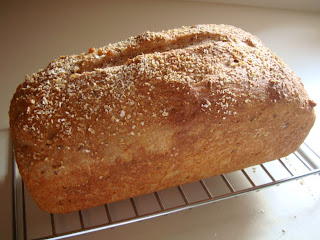Recipe: 100% whole wheat bread (make 1 medium loaf)
Ingredients:
- 3 cup King Arthur's whole wheat flour
- 1/2 tp active dry yeast
- 1+1/4 tps coarse kosher salt
- 2 TB buttermilk powder
- 3 TB non-fat milk powder
- 1 TB flaxseeds
- 1 TB oat brans
- 2 TB cooked wheat berries
- 1 TB honey
- 1 TB olive oil
- about 1+1/2 cup warm water
Procedure:
Day 1
1. Add active dry yeast to 2 TB warm water. Allow to proof for 5-10 minutes.
2. In a medium bowl, mix whole wheat flour with butter milk powder, milk powder, salt, flaxseeds, oat brans, and wheat berries.
3. Add the proofed yeast to the medium bowl. Then add water and slowly mix the ingredients together to form a dough.
4. Intermittently mix for a few minutes and let the dough rest for a few minutes. This allows dough to hydrate and autolyze gradually.
5. Chill dough for 3 hours.
6. Rub in honey and oil, kneading the dough thoroughly until soft and homogenous. Continue chilling overnight.
Day 2
1. Take dough out of the fridge and allow to warm up for several hours at room temperature on counter top.
2. About 2 hours before baking, shape dough and place it into a generously greased loaf pan. Minimize handling so as not to destroy any existing bubbles. Dough may still shrink a bit while being shaped. But it will rise again.
3. Brush top of dough with water and sprinkle oat bran as toppings. Then cover with foil. Proof at room temperature until dough has risen substantially above the pan top. Bake before dough falls out of shape.
4. Preheat oven to 450F. Place loaf pan in middle rack and set oven temperature to 350F. Bake for 30 minutes. Check after the first 15-20 minutes. Cover top with foil if browning is sufficient.
5. Unload pan and allow loaf to cool for an hour on cooling rack before slicing.
Results:
Day 1, 11:12am, initial ingredients mixed, yeast proofed, and warm water ready:
Day 1, 11:19am, initial mix of the ingredients:
Day 1, 11:28am, water added to soften dough and help dissolve the coarse milk powder:
Day 1, 11:33am, initial dough ready:
Day 1, 11:52am, initial dough flattened and rubbed with a little oil to prepare to be chilled:
Day 1, 3:12pm, dough chilled for 3 hours:
Day 1, 3:15pm, dough punched down; observe how it does not stick to the hand:
Day 1, 3:31pm, texture of dough after rubbing in the honey and olive oil:
Day 1, 3:34pm, final dough preparing to rest overnight:
Day 2
Day 2, 8:23am, final dough taken out of the fridge to warm up on counter at room temperature (72F):
2:00pm, final dough warmed up for 5.5 hours:
Day 2, 2:25pm, final dough shaped with minimal handling and placed in medium loaf pan generously greased with 1 tp butter; because of the minimal handling, dough appears sloppy:
Day 2, 2:25pm, final dough's height at the start of proofing:
Day 2, 2:28pm, final dough brushed with water and topped with oat brans at the beginning of proofing before covering with plastic:
Day 2, 3:25pm, final dough proofed at room temperature on stove top and covered with plastic, for 1 hour:
Day 2, 3:31pm, final dough's look just before baking:
Day 2, 3:31pm, final dough's height just before baking:
Day 2, 4:03pm, loaf baked for exactly 30 minutes; because of the low hydration, it's covered with foil after the first 20 minutes of baking to prevent over browning:
Day 2, 4:03pm, loaf's height:
Day 2, 4:04pm, loaf's bottom:
Day 2, 4:04pm, loaf's side:
Day 2, 4:04pm, loaf's top:
Day 2, 5:29pm, loaf yielding 12 thick slices:
Day 2, 5:29pm, side view of the slices:
Day 2, 5:29pm, a center-of-loaf slice:
Day 2, 5:29pm, an end-of-loaf slice:
Observations:
- This loaf is a success beyond doubt!
- The rise during the warming is spectacular.
- The holes in the loaf tend to be not very uniformly distributed. The bottom tends to be denser than the top. There are also some holes that are significantly bigger than the rest.
- Unlike my previous experiment with only 2 cups of flour, this loaf tastes more like a regular whole wheat loaf, fit for sandwiches.
- I make this loaf on the same day that I make burger buns from unbleached flour. In comparison, the whole wheat dough is a lot denser and harder to knead than the white dough. But because of the delayed fermentation, the whole wheat dough has sufficient gluten to give it the oven spring.
- The whole white loaf is much denser than the buns made from unbleached flour. They are simply different.





























No comments:
Post a Comment